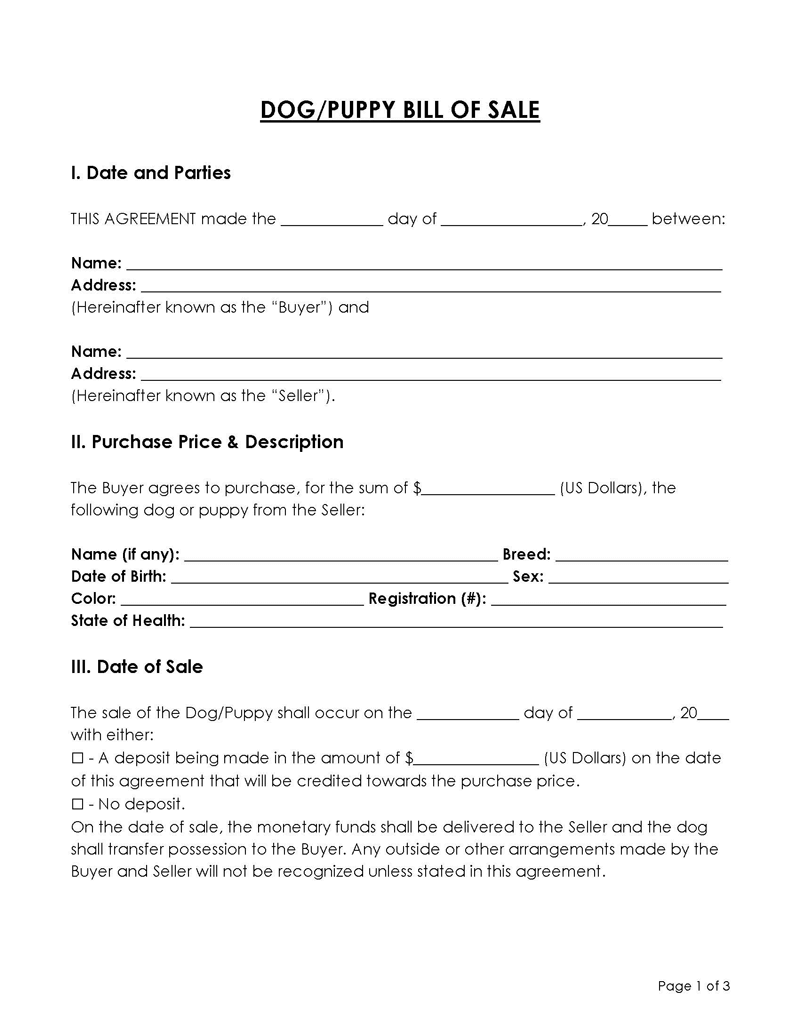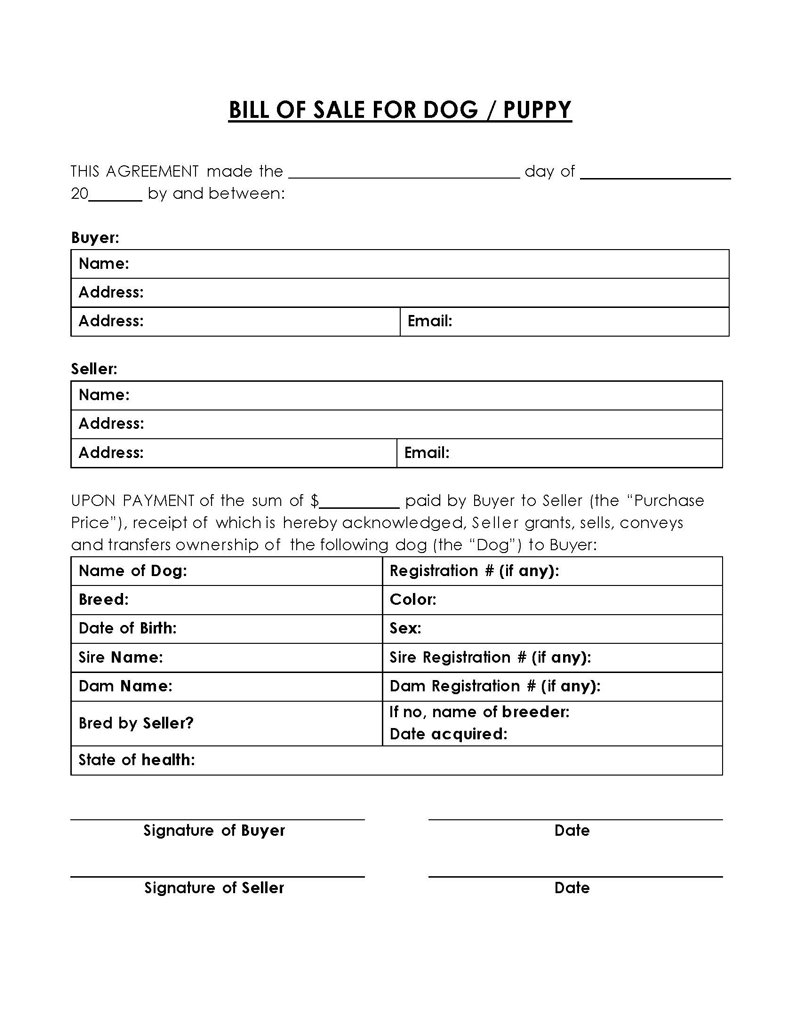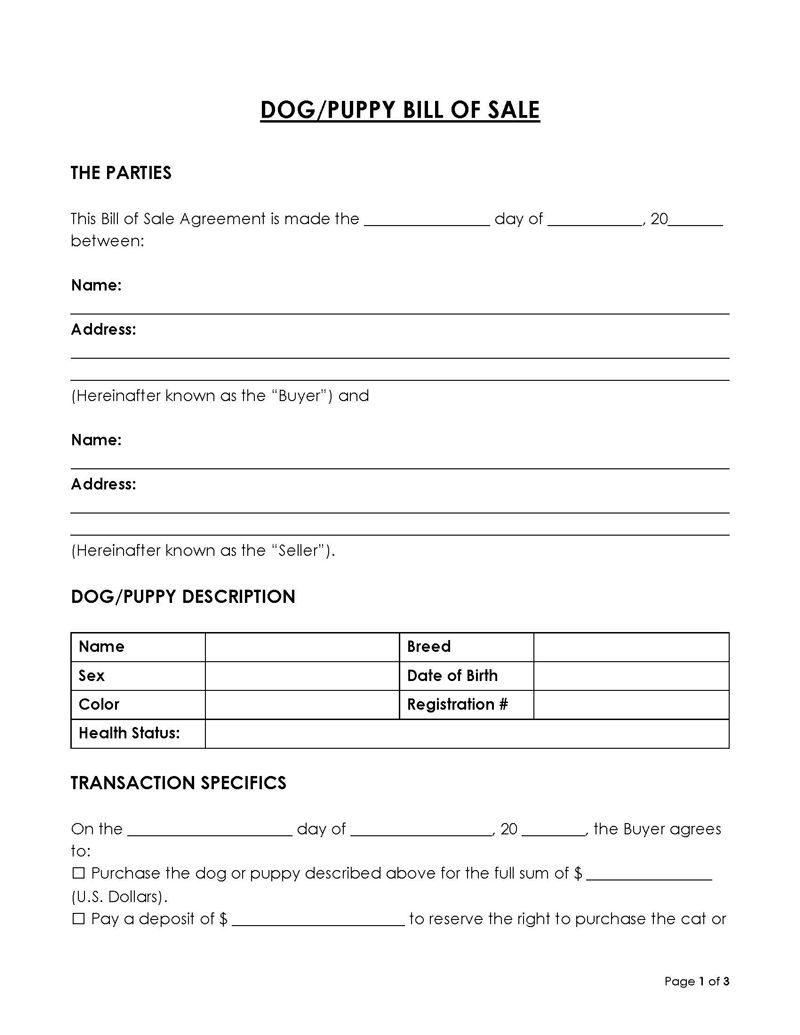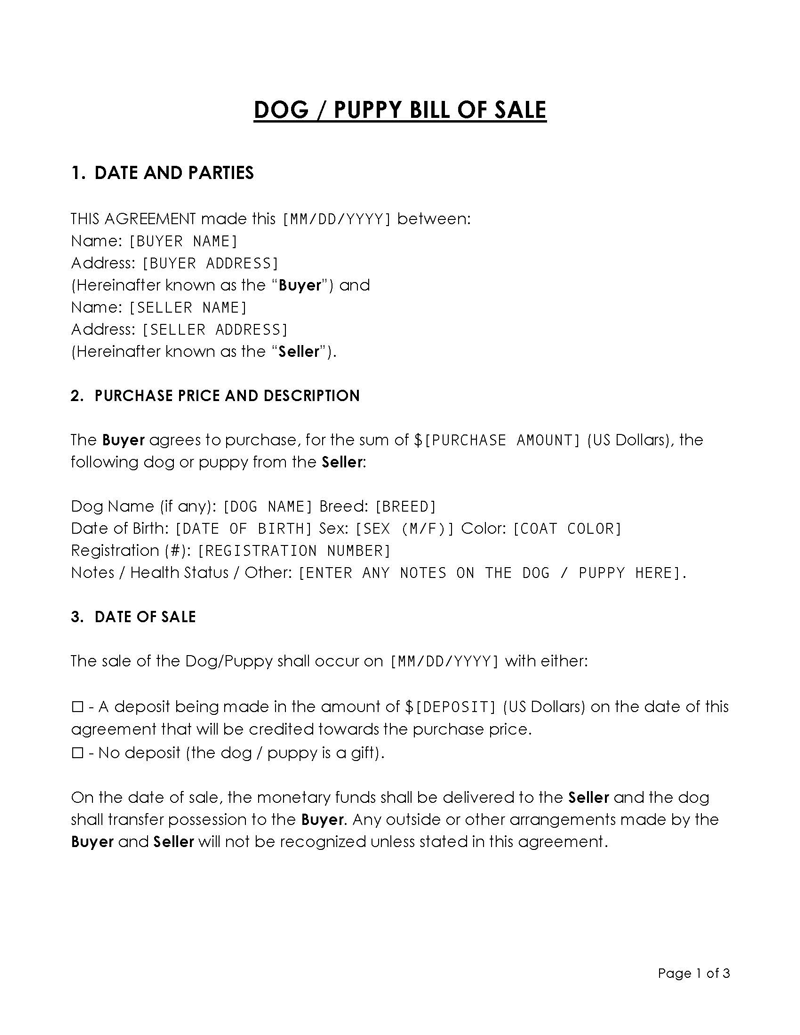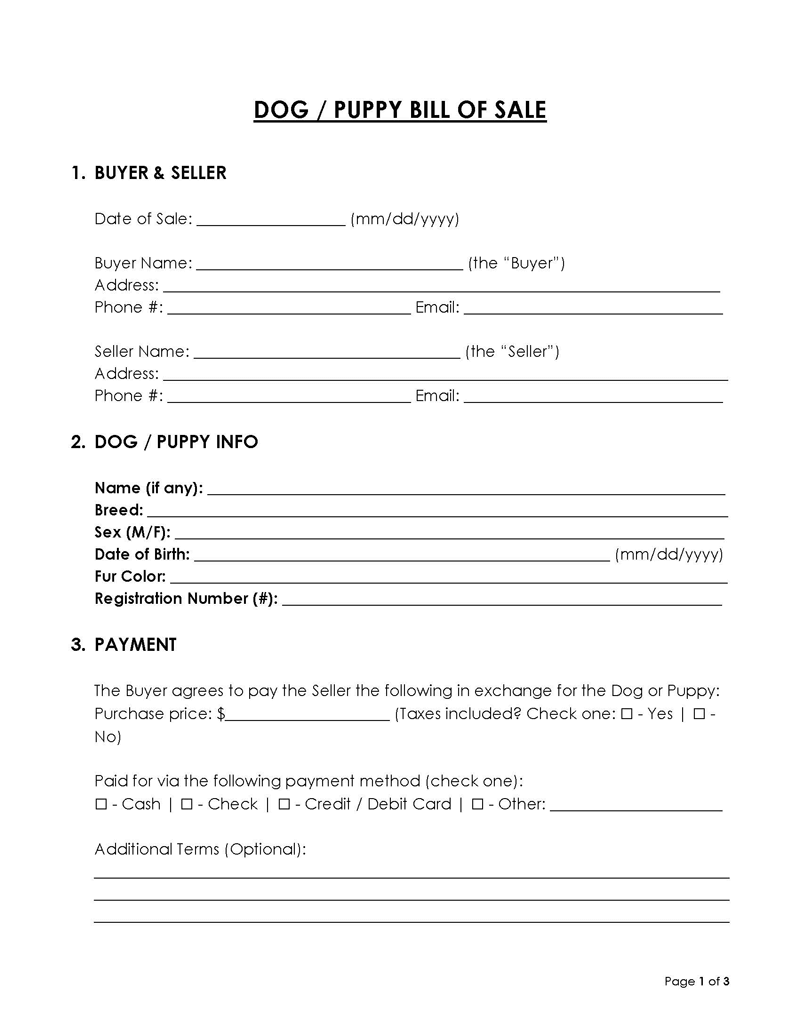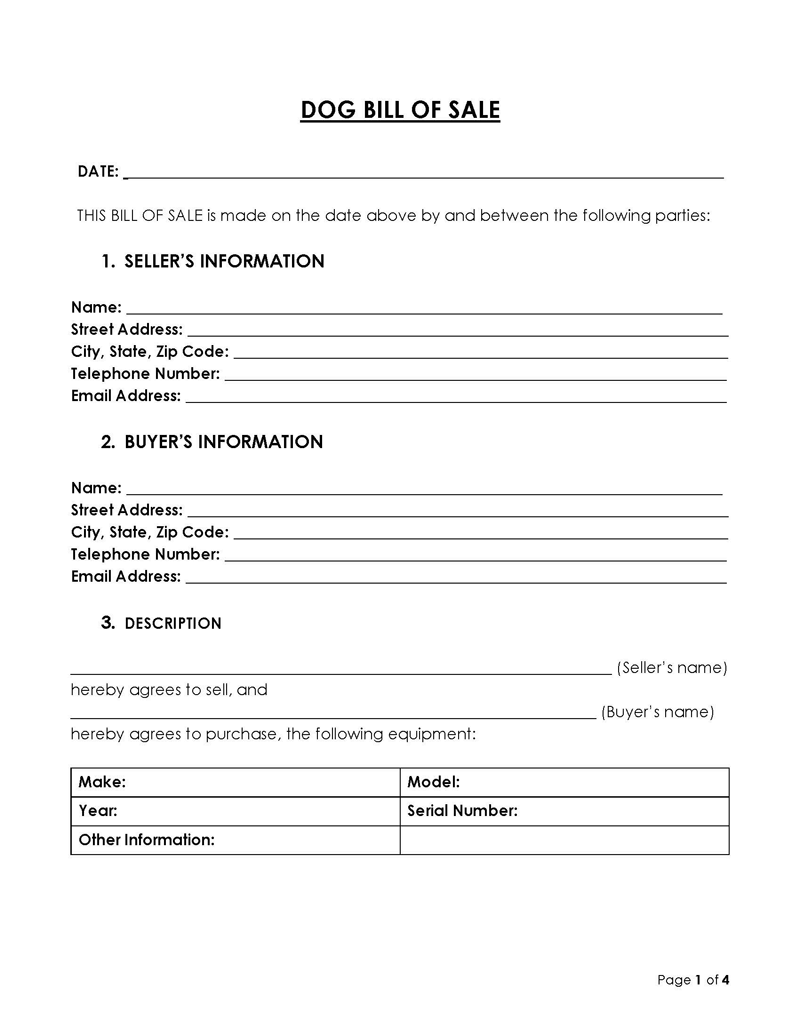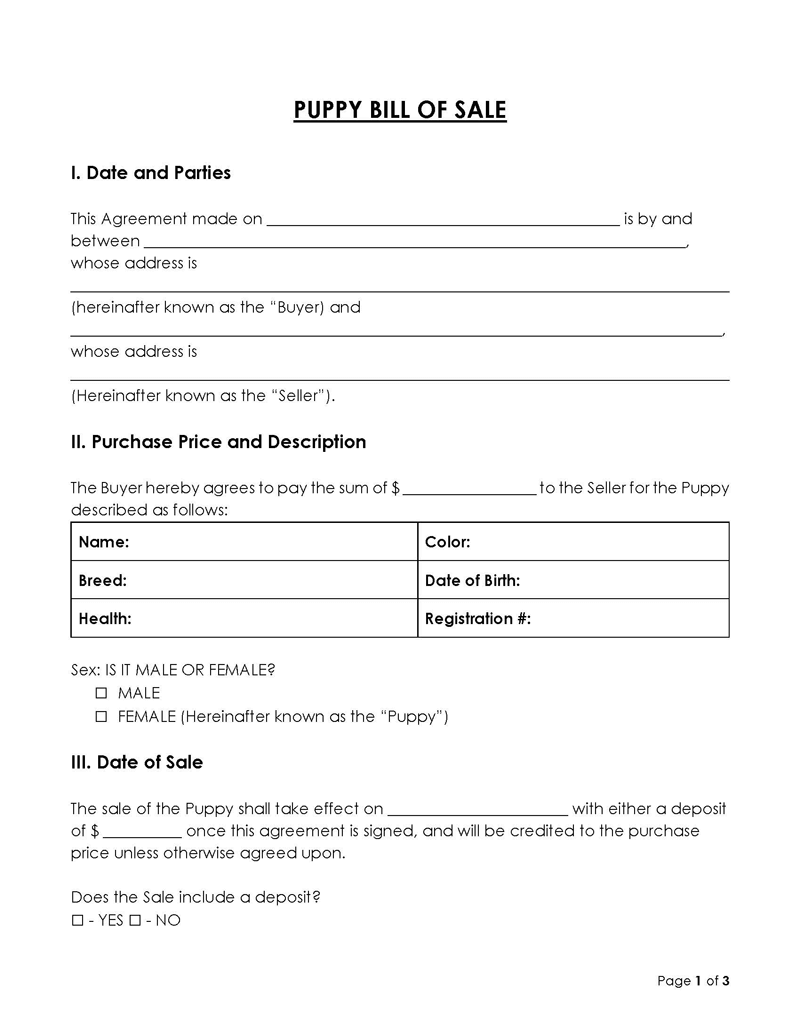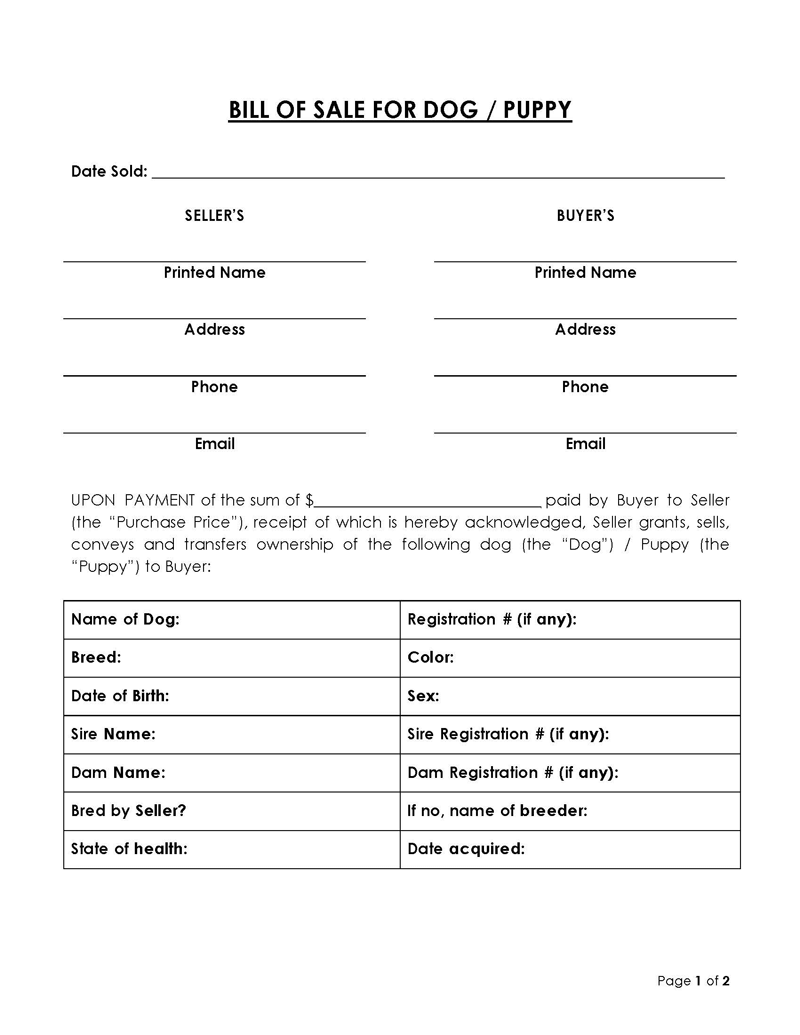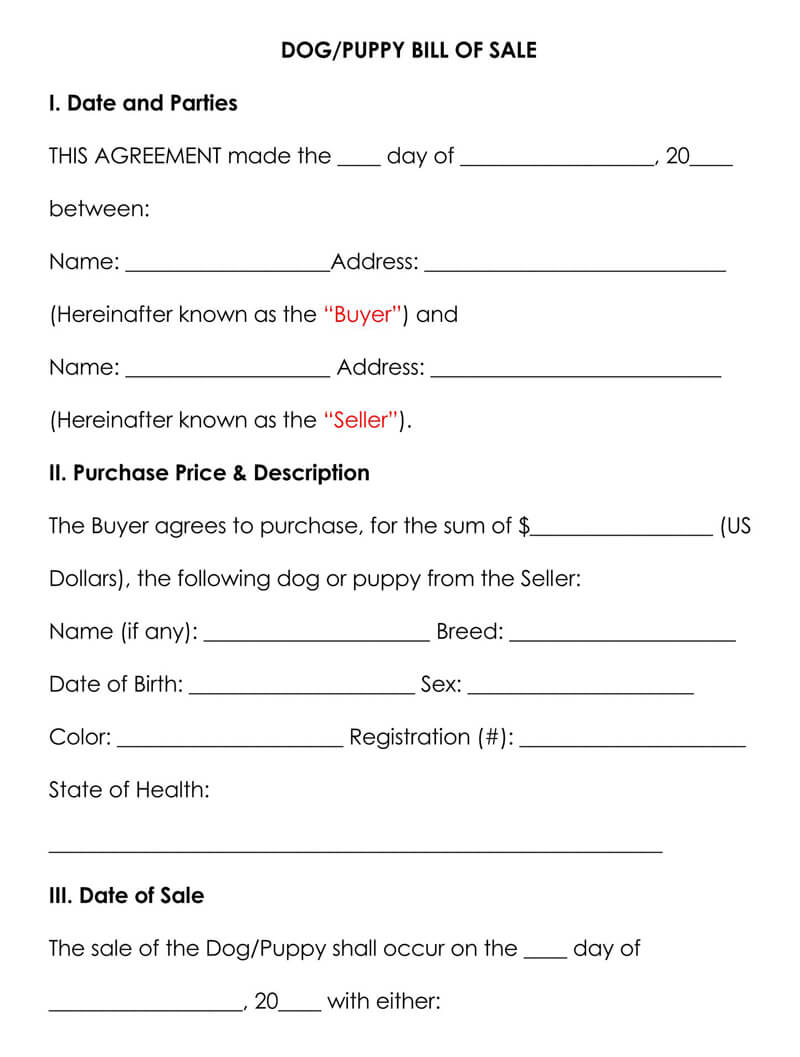A Puppy Bill of Sale or dog bill of sale shows that money has been exchanged for the ownership of the animal. They are legally binding contracts that protect both the breeder or seller of the animal as well as those making the purchase.
A properly written dog bill of sale acts as a receipt for the purchase of the pet. It protects the seller from having the purchaser come back to debate the viability of the sale or what they were getting for their money. In addition, it prevents the seller from coming back at a later time with issues about the sale.
A comprehensive puppy bill of sale for a puppy or young animal should include the following information:
- Date of purchase
- Location of the pet purchase
- Contact information for both the buyer and the seller
- The description of the breed, age, and AKC registration info
- The sale price of the pet
- Any other items that are part of the sale, such as a crate, dog bed, etc.
- Health documents that include information on exams and shots
- The age of the puppy or dog
- Shows a clear bill of sale between the two parties
One important thing to remember, if the dog is a year old or older, all medical records should be provided along with rabies tags, etc.
When is a Puppy Bill of Sale Required?
You should have a puppy bill of sale any time a pet is being bought or sold. This doesn’t just mean that the animal is a baby going to its first home. In many cases, people must give up their pets for a variety of reasons. Therefore, they should produce a puppy bill of sale for the new owners.
Other circumstances include:
- Selling a dog that can no longer be taken care of· Selling puppies as a dog breeder
- The promise to sell a puppy that hasn’t yet been born
- Selling or transferring ownership of a dog(s) for any other reason
The dog bill of sale is a legal document and outlines the terms of the sale. It proves the sale is completed and the animal is going to its new home.
Free Forms
Key Promises of the Dog Bill of Sales
A dog or puppy bill of sale is an important document for many reasons. First, it proves the transfer of ownership has gone from the original breeder or dog owner to the new owner.
It is important because it:
- Protects both the buyer and seller from any future misunderstandings after the transaction is final.
- Secures information on payments received before the puppy is born or isn’t old enough to leave its’ mother
- Proves the seller has the right to sell the puppy/dog
- Includes information about the dog’s breed, health, age, and overall health condition at the time of purchase
- Stipulates all warranties in case of fraud, misinformation, or other disagreements following the transfer of the animal to its new owner
Difference Between Bill of Sales and Adoption or Pet Contract
A puppy bill of sale and a pet adoption contract are two very different documents.
If you get a dog from a breeder, shelter, or pet adoption organization, you will be required to complete an adoption contract instead of a puppy bill of sale. An adoption contract is more far-reaching and contains more information than a puppy bill of sale, which typically states the ownership from one party to another.
An adoption contract usually includes agreements about what the pet parent needs to do to keep the dog safe. Often it may include stipulations like neutering/spaying the pet, keeping the dog inside or in a safe outside environment, and often requires registering the dog with the American Kennel Club.
Adoptions papers often have stipulations that state that if the pet is not a good fit for the individual or family, the original owner will take the pet back and try to place it with a different owner.
In many instances, a seller will combine a dog bill of sale and adoption contract into one, so there is only one set of papers.
How to Sell a Dog?
There are many ways to sell the dog, but the most important thing is to ensure the dog is going to a forever home. A home where they are loved, taken care of, trained, and nurtured. No one wants to sell a puppy that may be in harm’s way from people and other pets.
In most cases, potential buyers will want to know why the pet is being sold, whether it is spayed/neutered, and specifics like age, breed, temperament, etc. This will help them determine whether or not the dog is a good fit for their household. Sellers should always answer honestly. For example, if a buyer thinks a dog is potty trained or is good with children and this is not the case, it will mean another home for the dog, or else the initial owner may be asked to take the pet back.
Moreover, if the pet is aggressive or has an issue that can get someone hurt or killed, the seller should not give up or sell the dog unless the buyer is equipped to train the dog with behavioral issues.
Before Selling Your Dog, Do These Four Things
There are several things that sellers need to do before they sell their dogs.
Prepare the dog by making them look their best
When selling a puppy, the owner needs to make sure that the puppy is in the good physical condition and seen by a veterinarian. Many also get the puppy spayed or neutered before it is sold, as this is considered a positive unless the pet is to be used to sire other puppies. Also, as the breeder or owner of the pet, you will want your puppy or dog to make the best impression possible. Many sellers give the pet a bath and fluff up their coat to make them stand out from other puppies they may be considering.
Also, it should e noted that most breeders want to know ASAP if the pet won’t work out. Then, they will take the puppy back and find it a forever home.
Spread the word to friends and family
Many people find that posting an ad in the newspaper, online, Craigslist, or ASPCA are effective ways to sell a dog or puppy. However, the best thing to do is start asking family, friends, colleagues, and anyone else you know if they are looking for a pet. This is the best-case scenario as you will know who your pet is going to be cared for.
For example, the best home for your puppy or dog is with family, friends, work colleagues, etc., giving the seller peace of mind, knowing it is going to be a good home.
Prepare an eye-catching advertisement
If you are going to rely on an ad to bring in a purchaser, make sure you include a photo and all details about the animal.
Such as:
- Health and medical care
- Ancestry, is it an AKC registered animal?
- Is it a full breed?
- Is it good with children?
- Does it need special care, etc.?
Many also utilize their vets to help them get homes for their puppies. Many people will post a flyer with age, breed, price, background, and a photo. People that take their dogs to the vet already love animals. Often, a vet can pair people that have recently lost a pet with a new pet.
Here are some other common ways breeders use to sell puppies:
- Place an ad in your local newspaper.
- Post a flier at local pet supply shops and feed stores.
- Advertise in breed magazines.
- Network with members of local kennel clubs.
- Contact previous buyers of your puppies to ask for any referrals they may have.
Propose a meet and greet before securing the sale:
Don’t sell your dog to just anyone. You want to make sure they really want the animal and will provide a good home. So have a meet and greet before you sell your puppy. Either at a neutral place, your home, or their home.
As the right questions like, do they have a fenced-in yard? Is there anything that would put the animal in harms’ way? Are there children in the house? Are they old enough to care for the animal?
These are all questions that should be asked during the meet and greet.
Finalize the deal with a dog bill of sale
So, the perfect new family or individual has been chosen for your puppy or dog. This is the time you will complete the dog bill of sale with all pertinent information.
Included in the puppy bill of sale, you should:
- Date of purchase
- Add both the seller’s and buyer’s information with name, email, phone number, and full address.
- Include the Details of the dog containing the name, breed, color, sex, registration number of the dog
- Name and registration numbers of sire and dam.
- Any property goes along with the dog, such as toys, crates, dishes, bed, etc.
- Cost of security deposit and cost of the pet
- Include warranties if there are any
- Health information
- Name of the breeder other than the seller.
- Affix date and signatures of the seller, buyer, and any witnesses
Notarization seal according to state laws
To avoid any future issues, it is a good idea to get the dog bill of sale notarized. Then, after it is signed, the new pet owner can take possession of the pet. This is a good idea any time possession is sold.
State Laws Requirement
Most states require that a puppy be at least eight weeks old before being taken from its mother. Therefore, those selling the puppies should make sure they are able to be on their own before attempting to take the pet from its littermates and mother before it is sold.
| State | Citation and Link | Minimum Age Under Which the Puppy is not Sold |
| Alabama | ||
| Alaska | ||
| Arizona | ARS § 44-1799.04 | Less than eight weeks old |
| Arkansas | ||
| California | West’s Ann. Cal. Penal Code § 597z Cal. Health & Safety Code § 122045 – 122315 | Under eight weeks old |
| Colorado | CRSA § 35-80-108 | Under eight weeks old |
| Connecticut | CGSA § 22-354 | Under eight weeks old |
| Delaware | ||
| D.C. | DC CODE § 8-1808 | At least six weeks of age |
| Florida | F.S.A. §828.29 | Less than eight weeks old |
| Georgia | Ga Comp. R. & Regs. 40-13-13-.04(2) | Minimum eight weeks of age of the puppy before the sale |
| Hawaii | ||
| Idaho | ||
| Illinois | 225 ILCS § 605/2.2 | Until the puppy is 18 years of age |
| Indiana | I.C.§ 15-17-18-10 | Under the age of eight weeks |
| Iowa | ||
| Kansas | By administrative regulation: KS ADC 9-25-12 | The puppy should be eight weeks old and weaned i-e; it must have taken solid food for five days without nursing. |
| Kentucky | ||
| Louisiana | LSA-R.S. 3:2511 | Either dog or cats that are younger than 18 years old |
| Maine | By administrative regulation: 01-001 CMR Ch. 701, § I(N) | Until completion of the seventh week of life |
| Maryland | MD Code, Criminal Law § 10-613 | If not accompanied by its dam, then less than eight weeks old. |
| Massachusetts | By statute, MGLA 129 § 39G Also by admin. regulation 330 CMR 12.05 | Under eight weeks of age cannot be imported MGLA 129 § 39G Less than eight weeks old (330 CMR 12.05) |
| Michigan | MCL 287.335a | Younger than eight weeks old. Exemption for either animal shelter/protection agencies or large-scale breeding agencies that import underage pets with their dams. |
| Minnesota | M. S. A. § 347.59 | Less than eight weeks |
| Mississippi | ||
| Missouri | Admin. Regulation: 2 Mo. Code of State Regulations 30-9.020 (See subsection 14(E) (“Miscellaneous”)) | Weaned and less than eight weeks. |
| Montana | ||
| Nebraska | Neb. Rev. St. § 28-1018 | Less than eight weeks without the mother. |
| Nevada | N.R.S. § 574.500 | Weaned and eight weeks of age |
| New Hampshire | N.H. Rev. Stat. § 437:8 | Less than eight weeks of age |
| New Jersey | ||
| New Mexico | ||
| New York | McKinney’s Agriculture and Markets Law § 402 | Younger than eight weeks old |
| North Carolina | ||
| North Dakota | ||
| Ohio | RC § 955.50 | Under the age of eight weeks |
| Oklahoma | Okla. Admin. Code 35:55-5-2 | |
| Oregon | ||
| Pennsylvania | 3 PS § 459-603 3 PS 459-214 | Under eight weeks old |
| Rhode Island | ||
| South Carolina | Code 1976 § 47-1-200 | Less than eight weeks of age of the dog or a cat. |
| South Dakota | ||
| Tennessee | ||
| Texas | By administrative regulation: 16 TAC § 91.113 | Less than eight weeks of age of a dog or a cat |
| Utah | By administrative regulation: UT ADC R58-1-13(3) | If kittens and puppies are under the age of eight weeks then they are not allowed. |
| Vermont | ||
| Virginia | Va. Code Ann. § 3.2-6510 | Under seven weeks old without its dam or queen |
| Washington | ||
| West Virginia | ||
| Wisconsin | WSA 173.41 | Under seven weeks old |
| Wyoming |
Puppy Bill of Sale Templates
Following is a free downloadable dog bill of sale template for you:
Final words
Pets bring joy to our lives and can make our day-to-day lives a lot more fun. If you are breeding or selling puppies and dogs, make sure to complete a puppy bill of sale or dog bill of sale. This makes sure that all parties are on the same track and protects the buyer, the seller, and the pets.
